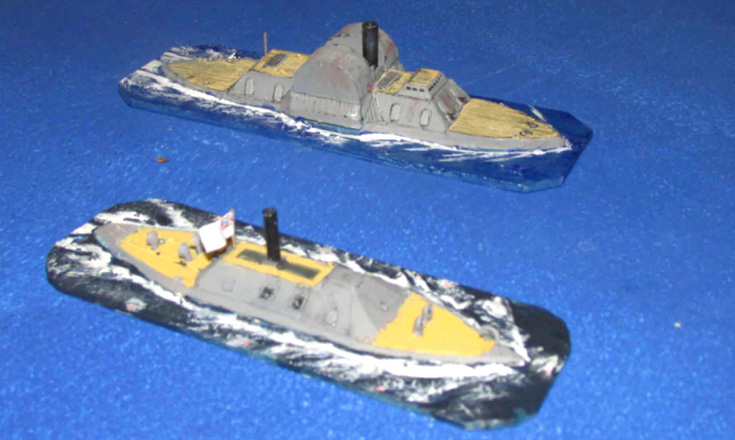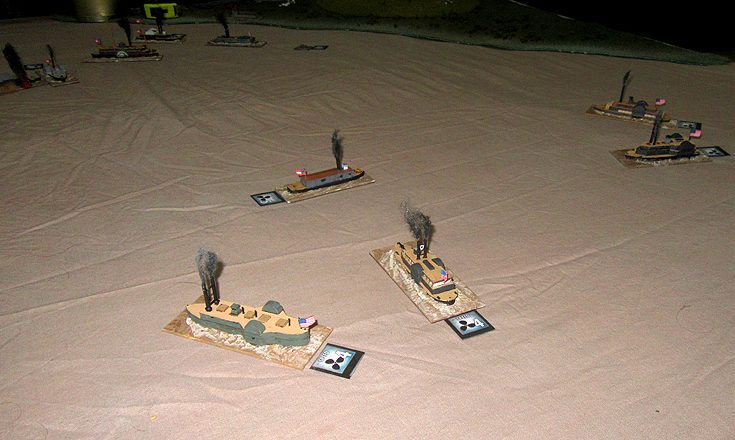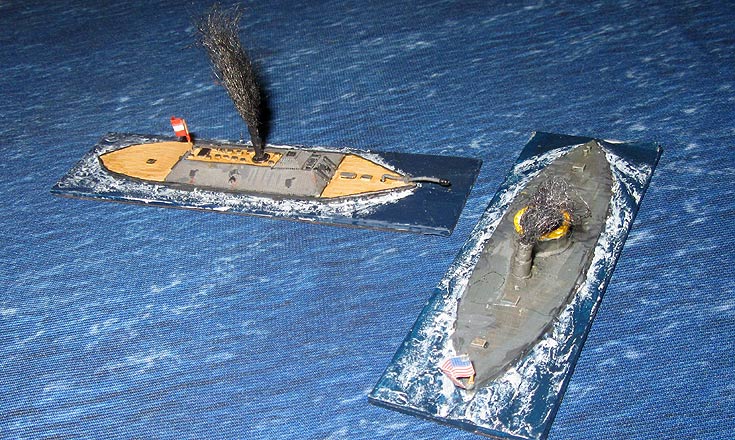
Mobile Bay, 1864
29th October 2013, 0 Comments
Ironclads, Bill’s Ironclad Rules, 1/600 scale
Bill Gilchrist and I have been developing a set of naval wargame rules. Actually Bill has been doing almost all the work – I’m just there to share the credit. They’re tentatively called Ironclad, and the plan is to have them published by Osprey, as part of their rules series. This game was only our third playtesting session, and was an non-historical game, set loosely around Mobile Bay towards the end of the American Civil War. A Union fleet of five monitors and four wooden sidewheel steamers launched an attack on the bay, which was defended by two forts – a big brick-built one, and a smaller earthwork. Just for the heck of it we sent the wooden steamers past the bigger fort, while the monitors pounded the smaller one into submission. A big minefield meant that the attackers had to pass close to the two forts, and these two deep-water channels were guarded by two Confederate squadrons – one of paddlewheel rams – the other of ironclads. Sorry for the lurid sea – Bill doesn’t care about tabletop aesthetics as much as I do! Actually the fire from the big fort wasn’t as galling as we’d expected – two of the Union paddlewheelers suffered serious damage as they steamed past – the other two emerged relatively unscathed. That though, was when the rebel rams struck. A combination of fire from the fort and the attention of the Confederate paddlewheelers led to the striking of the USS Miami and the diminutive Ceres. The other two Union paddlewheelers kept their distance, having run past the forts. Their job of course was done – they’d broken into Mobile Bay.
Actually the fire from the big fort wasn’t as galling as we’d expected – two of the Union paddlewheelers suffered serious damage as they steamed past – the other two emerged relatively unscathed. That though, was when the rebel rams struck. A combination of fire from the fort and the attention of the Confederate paddlewheelers led to the striking of the USS Miami and the diminutive Ceres. The other two Union paddlewheelers kept their distance, having run past the forts. Their job of course was done – they’d broken into Mobile Bay. The Confederate rams turned their attention to the line of three Passaic class monitors heading their way. The Passaic was rammed repeatedly, and suffered badly as a result. Still, her turret blazed away at her assailants, supported by the fire of her two sister ships. The battle ended with three of the Confederate rams reduced to floating wrecks, and they struck their colours. The last one – the Selma – didn’t want to face their fire again, and headed out into the Gulf of Mexico, bound for goodness knows where. On the other side of the entrance my two monitors Onondaga and Tecumseh had temporarily silenced the smaller fort, but now faced two Confederate ironclads – the Tennessee and the Nashville.
The Confederate rams turned their attention to the line of three Passaic class monitors heading their way. The Passaic was rammed repeatedly, and suffered badly as a result. Still, her turret blazed away at her assailants, supported by the fire of her two sister ships. The battle ended with three of the Confederate rams reduced to floating wrecks, and they struck their colours. The last one – the Selma – didn’t want to face their fire again, and headed out into the Gulf of Mexico, bound for goodness knows where. On the other side of the entrance my two monitors Onondaga and Tecumseh had temporarily silenced the smaller fort, but now faced two Confederate ironclads – the Tennessee and the Nashville. Both rebel ships rammed the Tecumseh, causing minor damage on her. Then though, they threaded past the Confederate ships, pouring fire into the unprotected sides of the Nashville as they went. She was battered so badly she struck, as did the Tennessee a couple of turns later. That left the third Confederate ironclad Tuscaloosa, which was much slower than her confreres. She too ended up battered by Union super-heavy guns, and spun out of control into the minefield. Actually the minefield was something of a disappointment in this game – none of the mines ever went off, even when ships blundered through the middle of the mined channel.
Both rebel ships rammed the Tecumseh, causing minor damage on her. Then though, they threaded past the Confederate ships, pouring fire into the unprotected sides of the Nashville as they went. She was battered so badly she struck, as did the Tennessee a couple of turns later. That left the third Confederate ironclad Tuscaloosa, which was much slower than her confreres. She too ended up battered by Union super-heavy guns, and spun out of control into the minefield. Actually the minefield was something of a disappointment in this game – none of the mines ever went off, even when ships blundered through the middle of the mined channel. That though, was a minor quibble. The rules are in a pretty nascent state, but they’re already robust enough to take the rough and tumble of a multi-player game. Bill and I will tweak them slightly before their next outing, but we honestly think we’re on to a winner with them – fast, fun and vaguely accurate. We still have a few problems with the longevity of ships in a gunnery duel, and with the way ships cope with damage, but the basics of the rules are solid enough, and they work.
That though, was a minor quibble. The rules are in a pretty nascent state, but they’re already robust enough to take the rough and tumble of a multi-player game. Bill and I will tweak them slightly before their next outing, but we honestly think we’re on to a winner with them – fast, fun and vaguely accurate. We still have a few problems with the longevity of ships in a gunnery duel, and with the way ships cope with damage, but the basics of the rules are solid enough, and they work.




